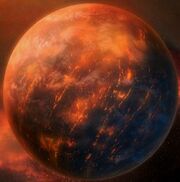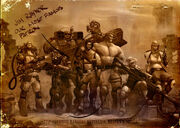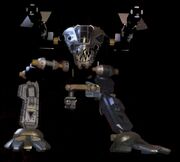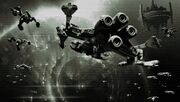
|
You may be looking for:
|
"Extended? Why?"
"Because, gentlemen, we are now officially at war with the Kel-Morian Combine."
- Major General Brantigan Fole and Captain Arcturus Mengsk at the start of the war.(src)
The terran Guild Wars were an economic and military conflict between the Kel-Morian Combine and the Terran Confederacy.
Background[]
- Bill to Confederate Lieutenant Arcturus Mengsk(src)
Moria benefited from having the largest resource mining operations in the Koprulu sector. When the Terran Confederacy was founded, the Morian Mining Coalition and the Kelanis Shipping Guild feared that it might attempt to move in and use its military strength to regulate their lucrative operations and merged to form the Kel-Morian Combine, which pledged military aid to any mining guild that was threatened by Confederate policy.[3]

Char was settled to exploit its fantastically rich reserves of heavy metals to fuel the rapidly growing Confederate economy. It became a source of friction between the Confederacy and independent mining guilds operating out of Moria.[4] Conflicts also broke out between Confederate and Kel-Morian mining guilds over exploiting the mineral wealth of Redstone III.[5]
Before the Guild Wars officially broke out, the Confederacy would "steal" Kel-Morian mining claims by sending intelligence personnel to scout the claims, then manufacturing excuses (such as claiming one of the miners was a wanted criminal, or that the claim was illegal), then attack "in order to rectify the situation." During the process, the claim would be taken and generally handed over to an Old Family and guarded by marines and other troops. Areas such as the Paladino Belt and the desert world of Sonyan were subjected to such tactics.[6]
Manpower[]
- Confederate corporal Thaddeus Timson(src)

Confederate soldiers
Overall, a Confederate soldier had access to better weapons and equipment than his/her Kel-Morian counterpart. The nature of those soldiers was another matter however. Some were volunteers, targeted in recruitment drives aimed at those graduating from secondary level education, the recruitment goals for said drives increasing as the war drew on. Enlistment bonuses were offered as well. Some individuals however, were drafted illegally, accounting for 1-2% of Confederate soldiers during the conflict. Advanced infantry training (AIT) was cut short in some cases due to the need for additional deployments. During the war, neural resocialization saw widespread, albeit basic use. This piqued Kel-Morian interest.
Due to changes in the Confederate military's command structure during the conflict, several wings of its armed forces were left struggling to adapt. The Internal Security Division further reported a lack of military police in its efforts to keep lawlessness in check.[7]
The Kel-Morian military was essentially composed of irregulars, as well as pirate and mercenary groups,[6] who often stripped Confederates of armour, weapons and equipment and applied it to their own ends. Kel-Morians were perhaps more fervent in their dedication to their cause, but were far from angels—controversy stirred up over the Combine's treatment of Confederate P.O.Ws and despite Combine claims to the contrary, such prisoners were sometimes subjected to horrific conditions, even torture.[7]
War Machines[]
Air/Space Warfare[]

The Kel-Morian Combine used the Hellhound, a laser-armed aerospace fighter, capable of engaging land and air targets. The Confederacy, meanwhile, was using the Avenger, which fired heat-seeking missiles at both land and sky.[7]
Space battles took place between large capital ships (such as Confederate and Kel-Morian[6] battlecruisers) and smaller gunships. Technicians on Tarsonis found that small, dynamic high-speed could repeatedly deal damage to large ships while still evading most defensive battery attacks.[3] The Wraith, armed with anti-air/space missiles and anti-ground lasers, was in use by 2485.[6]
Ground Combat[]

The goliath
LarsCorp Technologies built goliaths to serve as infantry support for the KMC. Corporate saboteurs stole the plans and sold them to the Confederacy.[3] Both sides were using the goliath by 2485.[6]
The siege tank was originally designed to serve as a "final defense" security cannon, but the versatility of the goliath showed that mobility was crucial in maintaining an effective military.[3] This version of the siege tank was in use by 2480.[6]
Diplomatic Alliances[]
During the war, Umoja played a role. Volunteers such as Forest Keel[1] fought for the KMC as unofficial combatants, most of whom reveled in the chance to battle the Confederacy. Graven Hill secured a lucrative contract with a mercenary outfit to protect valuable mining outposts. Hill and Remy Harris would later go on to pursue a more profitable contract with the Confederacy.[2] Umoja was also supported by the foremen of Pridewater, a Confederate fringe world planet — the foremen had secretly turned against the Confederacy.[1]
Events of the War[]
- Trace Raynor(src)
Shortly before the war broke out, the Confederacy received reports that the Kel-Morian Combine were planning major operations and would fight in a different manner than previously.[6]
Onuru Sigma[]
In 2485 the Terran Confederacy confronted the Kel-Morian Combine at the Noranda Glacier vespene refinery at Onuru Sigma. The vespene was contaminated with hydrogen sulfide, rendering it explosive.
By this point, the Confederacy believed the Kel-Morians were planning something big in that area. A detachment of Confederate Alpha Squadron led by Captain Edmund Duke and a detachment of the 33rd Ground Assault Division — Dominion section — led by Captain Arcturus Mengsk advanced on the dilapidated-looking complex, only to fall into an ambush. Many of the "abandoned" structures turned out to be strongpoints.
Duke lost many men recklessly charging the stronghold and had to take shelter in a strongpoint they had captured. Meanwhile, Mengsk called on Wraith air support to strafe the complex. As Mengsk's forces approached cautiously, they took fire, and many marines were killed or injured. A Wraith blew up a truck filled with vespene, and eventually the whole complex burst into flame as Mengsk's forces escorted the Alpha Squadron troops to relative safety.
The Confederates retreated, especially when they heard about Kel-Morian brigades and capital ships approaching the area. War was declared, and terms of service increased.[6]
Sonyan[]
The 33rd Ground Assault Division was deployed on Sonyan. There was a closely fought battle in the South Kreen Mines, during which Horace Warfield led a charge into a KMC bunker, taking three bullets in the shoulder as he cleared a vital position.[8]
Guerilla War[]
By late 2487, three of the five zones of the Koprulu sector were contested between the Confederacy and Combine. During this period, the Confederacy was hard pressed to react to guild guerrilla tactics.[7]
Tyrador VIII[]
In early 2488, Kel-Morians attacked a Confederate refinery on Tyrador VIII. Civilian casualties occurred as a result.[7]
Char[]
Some of the most bitterly fought battles of the war took place on Char as both sides attempted to secure the planet. In areas like Death Valley and Glass Flats, a combination of fiery volcanic activity and the unrestrained use of nuclear weapons created radiation levels that were lethal even for armored marines.[4]
In March 2488, Colonel Trelmont of the 2nd Regiment led Confederate troops in defending nuclear fortifications from Kel-Morian attackers, helping to force their retreat.[7]
Dylar IV[]
On Dylar IV, in mid-2488, a Kel-Morian special operations team successfully infiltrated a Confederate base. Seven marines were killed, three were wounded and another was regulated to life support.
At around the same period of time, an attack was carried out on Confederates stationed at the Dylarian Shipyards. Three soldiers were killed via a grenade.[7]
Raydin III[]
Raydin III was a battlefield between the two powers, specifically the town of Prosser's Well. The Confederates emerged victorious.[7]
Turaxis II[]
- Main article: Turaxis II campaign
Turaxis II was a bloody focal point in the war. The Confederacy tasked the 321st Colonial Rangers Battalion with high-priority missions there. In the war's last phase, a botched mission into KMC territory resulted in the friendly fire deaths of Confederate soldiers. Jim Raynor and Tychus Findlay went AWOL, even though their superiors were to blame for the operation's disastrous failure and resulting deaths.[9][10]
Other Battles[]
On Artesia Prime, Victor Kachinsky led a guerrilla squad of rippers in surgical strikes against the Confederacy, using spider mines to soften up Confederate forces before an ambush.[11] A Confederate convoy belonging to the 33rd Ground Assault Division was struck by spider mines. At least one casualty was sustained. The same division's Dominion section saw action on Parragos as well.[6] The Confederacy suffered another loss on Feronis, where a battalion of motorized infantry was defeated in the Battle of Hegeron.[7] The two sides clashed at Gamma Dorian in 2488, where the Confederacy won an initial victory, but many were killed by an exploding bridge.[12] Over the course of the war, the Confederacy "sold out" some of its colonies.[13] The settlement of Pitt Town, New Sydney, a Confederate planet, was destroyed during the war.[14]
The following section contains information from StarCraft II that is ambiguously canonical.
|
Mar Sara was a site of battle during the war. The 321st Colonial Rangers Battalion carried out actions there.[15]
Finale[]
- Ailin Pasteur(src)
Impending Confederate victory became obvious long before the war officially ended.[6] In April 2489, Confederate representatives agreed to discuss the possibility of a ceasefire.[7] The wars ended with a skewed peace treaty in which the KMC retained its autonomy but almost all of its affiliated mining guilds were appropriated by the Confederacy.[3] Seeing this as utterly abusive, the Umojan Ruling Council held an emergency sitting and formed the Umojan Protectorate.[16]
Home Fronts[]
- Major Lionel Macaby(src)
During the conflict, the people of the Confederacy had mixed fortunes. Tarsonis survived unscathed and the Old Families made enormous profit from selling weapons and equipment to the Confederate Armed Forces. On the other hand, increases in military spending damaged the Confederate agricultural sector, sending some independent farmers into bankruptcy. Due to the Combine's attempt at resource control, taxes were raised, new businesses regulations were levied, fuel was rationed and food shortages were experienced. Shiloh served as a notable example. There were even those amongst the Old Families who pushed for a rise on colonial property taxes in order to better recover the cost of military protection—on a per capita basis, it was more expensive to defend a sparsely colonized fringe world than a densely populated one.
Media access to the Confederate military was limited, leading some to cynically dub the conflict as "the quiet war." Airing of uncensored war footage led to a scandal at UNN led to president Preston Shale stepping down. The Confederate line was that were the Kel-Morians to succeed and topple the Confederate government, it would result in effective slavery for all Confederate citizens, as Kel-Morian guilds were hereditary in membership.[7]
The Confederacy relied heavily on Shiloh's agricultural output during the wars, and there were hard times when the government was slow in remunerating the overtaxed farmers. These conditions were eased somewhat by the Farm Aid program, but they created lingering resentment among the settlers.[17]
Heavy rationing was put into effect through the war, including rations on civilian food. However, as the war went on the Confederacy began to cut corners on the foodstuffs they supplied, and cheaper can materials lead to an outbreak of a rare form of cancer among many of those who relied on Confederate rations.[14]
On the Combine front, Moria escaped the conflict unharmed.[18]
Legacy[]
- Jim Raynor on the Guild Wars(src)

Confederate space forces after the war's end
In the final analysis, the Guild Wars assured Confederate supremacy in the sector,[3][19] which would be unchallenged for the next decade.[20]
Although it lost the war, the political influence of the KMC became so great that the Confederate forces were banned from prosecuting the KMC for any potentially criminal action. It was rumored that this was because the KMC actually supplied the Confederacy with fuels and resources.[3] Tarsonis meanwhile enjoyed an economic boom which lasted until war broke out with the Sons of Korhal, protoss and zerg.[13] The Protectorate profited from the war in a sense in that war-weariness prevented the Confederacy from following up on the Protectorate's salvage of its battlecruiser, Hyperion.
The Guild Wars became the subject of a degree of literature, such as the digi-tome History of the Guild Wars[1] and The Guild Wars.[7] The Daughters of the Guild Wars Veterans was a Confederate charity group that honored Confederate soldiers who fought in the wars, erecting memorials for them.[13] In time, the conflict became "legendary."[21]
References[]
|
| Major Koprulu Conflict | ||
|---|---|---|
| Preceded By | Duration | Succeeded By |
